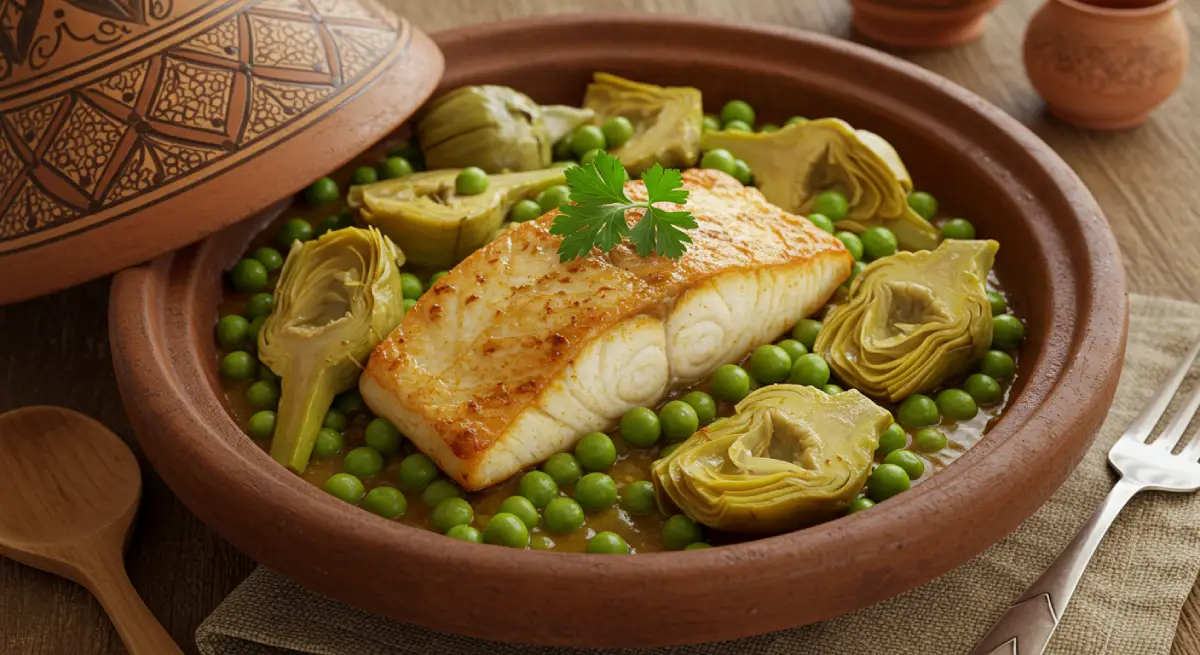Table of Contents
🐟What Makes This Fish Tagine So Special?
🇲🇦 The Cultural Roots of Moroccan Fish Stew
Fish tagine is not just a dish; it’s a vibrant cultural experience. This iconic Moroccan recipe has deep roots in the coastal regions, where the fusion of fresh ocean fish and North African spices creates a culinary masterpiece. Over generations, families have perfected their fish tagine recipes, passed down with love and care, using locally caught fish and traditional clay pots.
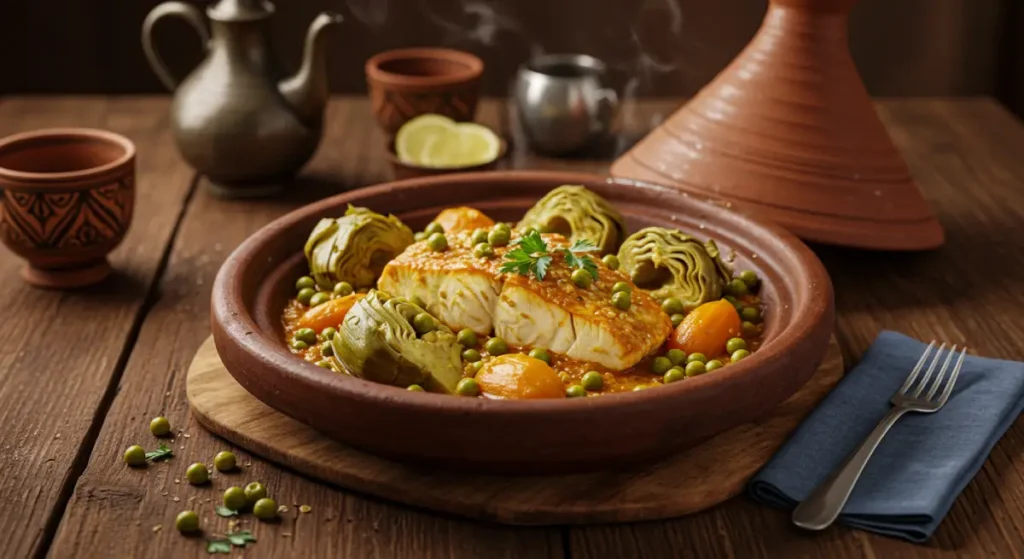
In Moroccan culture, fish tagine is more than a simple meal, it’s a celebration of life. It symbolizes health, abundance, and togetherness, often gracing everyday tables and festive occasions. Much like the well-loved Harira, fish tagine is woven into the fabric of Moroccan hospitality, bringing people together to share food and memories.
The name “tagine” refers to the dish and the unique earthenware pot used for cooking. This pot is designed to retain moisture and amplify flavors, making preparing the perfect fish tagine essential.
🔥Why Tagine Cooking Enhances Flavor
What truly sets fish tagine apart is the method of cooking. The tagine pot creates a slow, steamy environment that ensures the fish remains tender and absorbs the complex flavors of preserved lemons, olives, garlic, and chermoula. Unlike methods like baking or frying, tagine cooking draws out the natural sweetness of vegetables while intensifying the savory elements of the dish.
This technique is perfect for lean proteins such as fish, which thrive under moist heat and produce a flaky, juicy texture. The fish tagine becomes an explosion of bold Moroccan flavors, with each bite transporting you to the heart of Morocco.
If you love seafood tagines, you’ll also appreciate our guide on Shrimp & Calamari Tagine, a perfect companion for your tagine journey.
🥗How This Dish Fits a Healthy Mediterranean Lifestyle
Fish tagine is an excellent addition to a Mediterranean diet. It’s low in saturated fats, rich in heart-healthy omega-3 fatty acids, and packed with nutrients from fresh vegetables like tomatoes, peppers, and carrots. When paired with whole grains like couscous and a fresh salad, fish tagine forms a balanced, nutritious meal that supports heart health, reduces inflammation, and may even boost brain function.
Experts, such as those at the Harvard T.H. Chan School of Public Health, often hail the Mediterranean diet as one of the healthiest in the world, and fish tagine is a proud example of this dietary tradition.
🌿A Culinary Bridge Between Land and Sea
Fish tagine beautifully bridges the flavors of land and sea. Whether you’re using sardines, cod, or whiting, the Moroccan spice blend brings out the essence of the fish, enhanced by the earthy notes of cumin and the fresh, zesty brightness of cilantro. It’s a dish that feels rustic and refined, offering a unique balance of flavors that makes each bite memorable.
If you’re curious about other seafood treasures, don’t miss our Golden and Savory: How to Make Moroccan Seafood Bastilla, another dish deeply rooted in Moroccan culinary traditions.
✨Final Thoughts
What makes fish tagine so special? It’s the perfect union of cultural heritage, health-conscious cooking, and unforgettable flavor. Whether you’re new to Moroccan cuisine or a long-time fan of tagine, this dish invites you to slow down and savor every bite.
Next time you’re looking for a comforting yet healthy meal, let the humble fish tagine transform your table into a Moroccan feast. 🇲🇦
🍋Essential Ingredients for a Flavor-Packed Fish Tagine
🐟Fresh White Fish: Choosing the Best Cut
The heart of an excellent fish tagine lies in selecting the freshest fish. Choose firm white fish such as cod or sea bass for a light yet flavorful dish. These fish varieties are perfect for slow cooking in a tagine, as they absorb the rich spices without losing their texture.
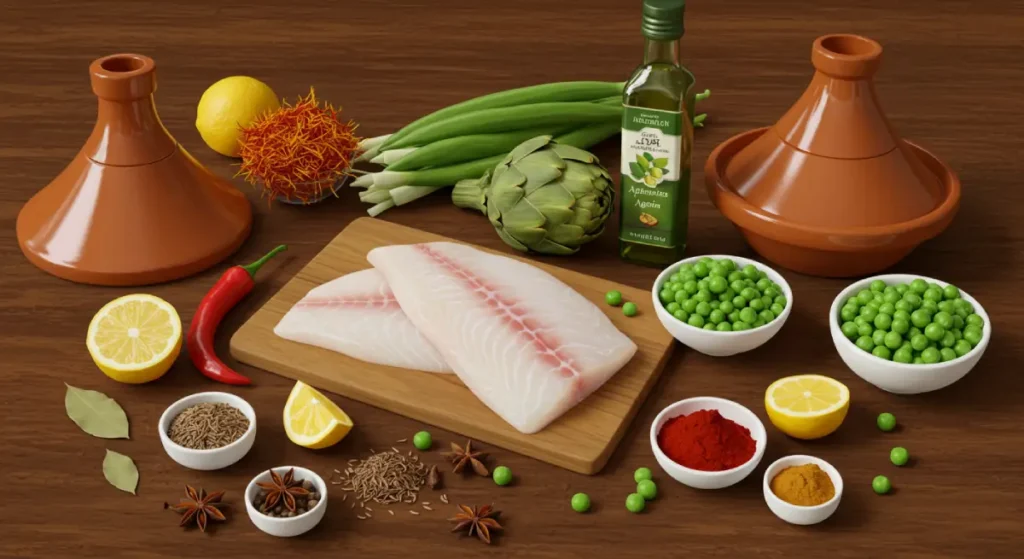
When shopping for fish, look for a clean, ocean-fresh smell and firm flesh. Fresh fish holds up better in the tagine’s steamy environment, maintaining its delicate texture and allowing the spices to shine. Avoid pre-frozen fish when possible, as it can affect your tagine’s flavor and texture.
🌶️The Perfect Spice Mix: Saffron, Cumin, Paprika & More
A flavorful fish tagine is built on the perfect spice blend. Key ingredients like saffron, cumin, and paprika form the base of Moroccan seasoning, each adding its unique touch.
- Saffron imparts a delicate, earthy flavor and vibrant color to the dish.
- Cumin adds a warm, nutty undertone, while
- Paprika introduces a mild, smoky depth.
These spices and optional additions, such as turmeric, cinnamon, and coriander, create a complex, aromatic profile that perfectly complements the fish.
For more insights on essential Moroccan spices, visit our guide on spices you can’t miss in Moroccan cooking.
🍋Why Preserved Lemons and Olive Oil Matter
No fish tagine is complete without preserved lemons. These tangy, salty fruits are a staple of Moroccan cuisine, offering a burst of flavor that balances the richness of the fish. The bitterness of the preserved lemons enhances the dish’s complexity, bringing everything together in harmony.
High-quality olive oil also plays a crucial role in the tagine. It helps distribute the spices evenly throughout the dish, adding richness and depth to the overall flavor profile. Preserved lemons and olive oil elevate your fish tagine to a new level of deliciousness.
🥒Optional Touches: Artichokes, Peas, and Herbs
While the base ingredients of a fish tagine create a traditional and flavorful dish, you can add a few optional additions to enhance the experience.
- Artichokes bring a tender texture and subtle nutty flavor that pairs wonderfully with fish.
- When in season, peas add a pop of color and a sweet freshness that complements the tangy preserved lemons.
- Fresh herbs like cilantro and parsley can be sprinkled on top just before serving, providing a burst of green to contrast with the rich spices and adding a refreshing touch.
These additions are optional, but they can elevate your fish tagine to a new level, making it visually stunning and even more delicious.
🍲Step-by-Step Guide to Making the Best Fish Tagine
🍳Preparing Your Tagine Pot or Dutch Oven
The first step to making the perfect fish tagine is choosing the right cooking vessel. While a traditional tagine pot is ideal for this dish, you can also use a Dutch oven or any heavy-bottomed pot that ensures even heat distribution for slow cooking.
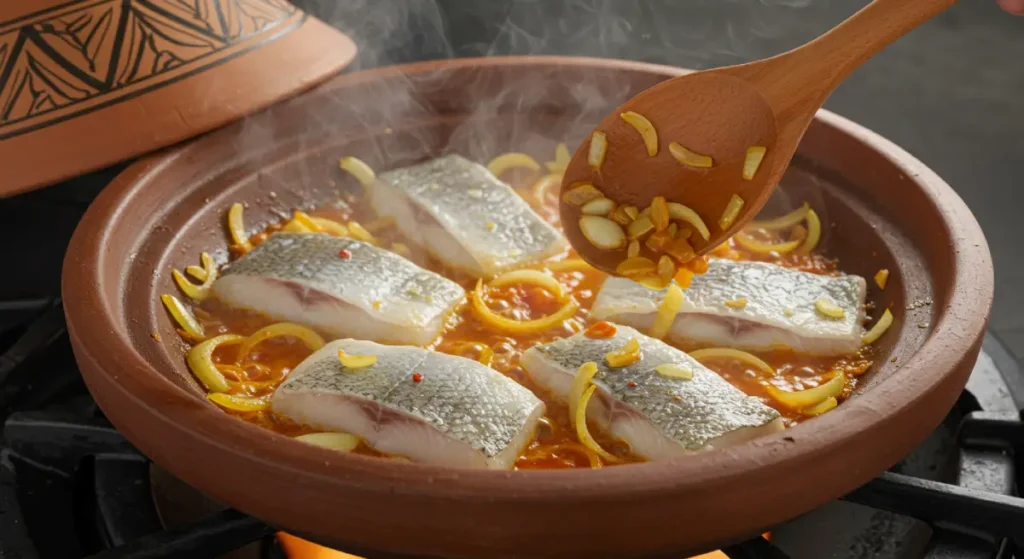
- Season a tagine pot before using it for the first time. Wash it thoroughly, coat the inside with a thin olive oil, and heat it on low for about an hour. This will prevent cracking and improve the cooking process.
- For a Dutch oven: Ensure it has a tight-fitting lid to trap the steam and ensure the fish cooks evenly.
The right vessel significantly enhances the flavors and ensures the fish tagine turns tender and flavorful..
🧄 the Aromatics: Garlic, Onions, and Spices
Next, you’ll need to sauté your aromatics to build the foundation of your fish tagine’s flavor. Begin by heating a couple of tablespoons of olive oil in your pot. Add finely chopped onions and garlic, cooking them until they’re soft and fragrant. This step is essential for releasing the natural sugars in the onions and the depth of flavor in the garlic.
Once your aromatics are ready, it’s time to add the spices. Start with cumin, paprika, turmeric, and a pinch of saffron. Toast these spices in the oil to release their full aroma before adding the following ingredients. These warm spices will create a deep and flavorful base for your fish tagine.
🐟Layering Ingredients for Maximum Flavor
Now that your aromatics and spices are prepared, it’s time to layer your ingredients. This step is essential to achieve a balanced flavor in your fish tagine.
- Start with a layer of vegetables, sliced carrots, zucchini, or tomatoes work well.
- Then, add your fish fillets to the vegetables, ensuring they are evenly distributed for optimal flavor absorption.
- Preserved lemons, olives, and artichokes (if desired) can be added to the fish. These ingredients add tang and earthiness, enriching the tagine as it cooks.
By layering the ingredients, each fish and vegetable gets thoroughly marinated in the spices, ensuring every bite is flavorful.
⏳Slow-Cooking to Perfection: Time and Technique Tips
Slow cooking is key to making a perfect fish tagine. This method allows the spices to meld and the fish to remain tender.
- Cover the tagine pot or Dutch oven with a tight-fitting lid to trap the steam and cook on low heat. If using a traditional tagine pot, use a heat diffuser to prevent direct heat from the flame.
- Generally, 25-30 minutes on low heat is enough for the fish to cook through. The goal is to cook the fish gently, avoiding overcooking, which can cause it to become dry and lose its delicate texture.
Test the fish’s doneness by gently pressing it with a fork to check for tenderness. Once it’s done, let it rest for a few minutes before serving to allow the flavors to settle. Garnish with freshly chopped herbs like cilantro and parsley for a burst of freshness that complements the rich spices of the tagine.
🍽️Serving Suggestions and Perfect Pairings
🍚Couscous, Warm Bread, or Rice: What Works Best?
When serving a fish tagine, choosing a side dish that complements the rich, spiced flavors without overpowering them is essential. The ideal choice depends on your preferences, but couscous, warm bread, or rice make excellent companions.
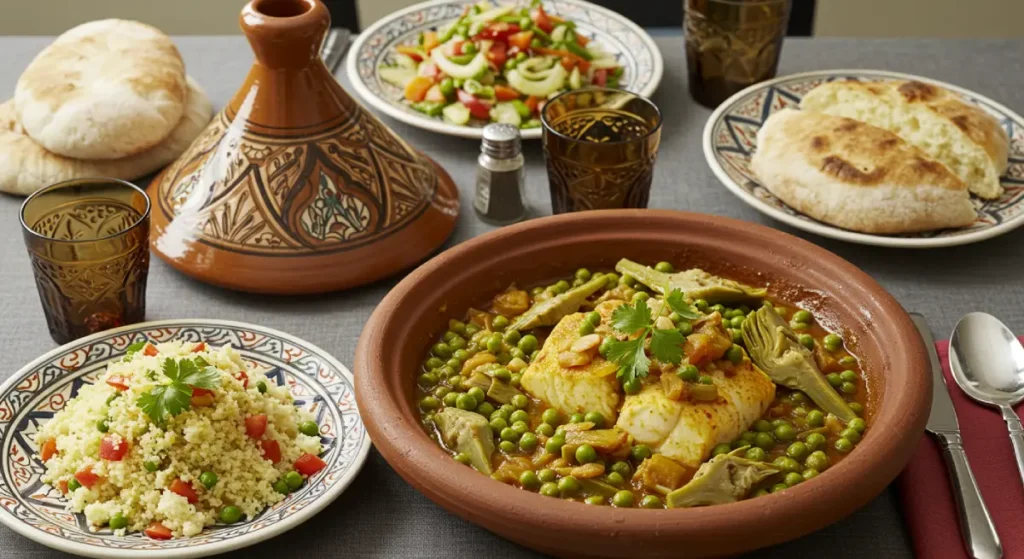
- Couscous is the classic choice for tagines. Its light, fluffy texture pairs perfectly with the tender fish, soaking up the flavorful sauce and spices. You can opt for instant or traditional steamed couscous for a quicker option. Consider mixing in a few raisins or almonds for added texture and flavor.
- Warm bread is a hearty option, especially if you prefer a satisfying bite. A crusty Moroccan bread like khobz is ideal for mopping up the delicious sauce. Its chewy texture contrasts nicely with the softness of the fish, enhancing the overall meal experience.
- Rice is another excellent pairing. Simple white rice or a saffron-infused pilaf can enhance the Mediterranean flavors of the tagine. It’s a fantastic gluten-free alternative to couscous or bread, and it adds a nice neutral base to balance the spices.
For more on Moroccan side dishes and bread pairings, check out our guide to Moroccan couscous!
🥗Refreshing Sides: Moroccan Salads or Roasted Veggies
To balance the richness of your fish tagine, serve it with refreshing sides like Moroccan salads or roasted vegetables. These sides add freshness and texture to the meal, making each bite more satisfying.
- Moroccan salads are light, flavorful, and full of contrast. Consider serving Zaalouk (a cooked eggplant and tomato salad) or Taktouka (a spicy tomato and pepper salad). These vibrant salads offer freshness that perfectly complements the savory depth of the fish tagine.
- For a more substantial side, roasted vegetables make an excellent choice. Roasted carrots, sweet potatoes, or bell peppers add flavor and texture, with their caramelized edges offering a delightful contrast to the tender fish. Roasted root vegetables like parsnips or beets also pair wonderfully with the earthy notes of preserved lemons and olives in the tagine.
🌿How to Garnish Your Tagine Like a Pro
Garnishing your fish tagine is an easy yet effective way to elevate the dish. A well-chosen garnish adds visual appeal while enhancing the tagine’s flavor and aroma.
- Fresh herbs like cilantro or parsley are perfect for sprinkling just before serving. Their green vibrancy contrasts with the rich, spiced base of the tagine, providing a refreshing note.
- Preserved lemons are another essential garnish. Thinly slice them and scatter them over the dish. Their tangy and salty flavors balance the richness of the fish and spices. You can also add a few green olives for an additional Mediterranean touch.
- If you’re feeling adventurous, toasted almonds or pine nuts make an excellent crunchy garnish. They add a delightful texture and a slightly nutty flavor that pairs beautifully with the soft fish and aromatic spices.
🍹Drinks That Enhance the Mediterranean Vibe
No meal is complete without the right drink, and a fish tagine is no exception. Pairing the right beverage enhances the Mediterranean experience and complements the dish’s bold flavors.
- Mint tea is the quintessential Moroccan drink. Whether served hot or cold, its refreshing, slightly sweet flavor is perfect for cleansing your palate between bites. The fresh mint provides a taste that beautifully balances the richness of the fish tagine.
- For wine lovers, a dry white wine like Sauvignon Blanc or a crisp rosé pairs wonderfully with the delicate fish and aromatic spices. The acidity of these wines cuts through the dish’s richness, enhancing its subtle flavors.
- If you prefer non-alcoholic beverages, fresh fruit juices like orange or pomegranate juice provide a sweet, tangy contrast to the savory fish tagine. For a lighter option, serve sparkling water to refresh the meal without overwhelming the flavors.
🥡Tips for Storing, Reheating, and Meal Prep
🏺How to Store Leftovers Without Losing Flavor
Proper storage is key to keeping its delicious flavor intact if you’ve made a large batch of fish tagine. To store leftovers:

- Cool it down: Allow the fish tagine to cool to room temperature before refrigerating it. This prevents steam from accumulating, which can make the dish soggy.
- Use airtight containers: Store the tagine in a glass or plastic container. Cover any leftover sauce, as it helps keep the fish moist and flavorful.
- Storage time: Eat leftovers within 2–3 days for the best taste. While the spices may develop more depth over time, consuming them sooner will ensure you enjoy them at their peak.
For more food storage tips, visit this helpful guide from the U.S. Food Safety website.
🔥Best Reheating Practices for Fish Dishes
Reheating fish tagine properly ensures that the fish remains tender and flavorful. Here are the best methods:
- Stovetop: Transfer the fish tagine to a pan, add a splash of water or broth, and cover. Heat on low, stirring occasionally to prevent burning until thoroughly warmed. This method helps preserve moisture and enhances the flavor.
- Oven: Preheat your oven to 300°F (150°C). Place the tagine or casserole dish in the oven for 15-20 minutes, covered with foil to lock in moisture. Use a thermometer to check that the internal temperature reaches 165°F (74°C) for safe consumption.
Avoid microwaving the tagine, as it tends to dry out the fish and overcook it. For even better results, reheating fish tagine the next day improves the flavor as the spices meld.
❄️Freezer-Friendly Version Tips
If you want to make fish tagine ahead of time and freeze it for later, follow these tips to maintain the best quality:
- Cool completely: Let the tagine cool fully after cooking.
- Airtight storage: Store it in an airtight container or a freezer-safe bag. If using a bag, remove excess air to prevent freezer burn. It can be stored for up to 3 months.
- Thawing and reheating: For the best results, thaw the fish tagine overnight in the refrigerator. Once melted, reheat using the stovetop or oven methods. If you’re in a rush, you can reheat it directly from the freezer, but add extra time to ensure it’s heated thoroughly.
🍲Using Leftover Tagine in Creative Ways (Wraps, Bowls, Etc..)
Don’t let your leftover fish tagine go to waste! You can repurpose it into new dishes for a fresh take on the flavors. Here are some creative ideas:
- Fish Tagine Wraps: Use the leftover fish tagine in a soft flatbread or tortilla. Add fresh greens, olives, and a yogurt or tahini sauce drizzle for a Mediterranean-inspired wrap.
- Fish Tagine Bowls: Turn your leftovers into a grain bowl for a filling lunch. Layer it with quinoa, couscous, or rice, and add roasted vegetables or a side salad for a balanced meal.
- Fish Tagine Tacos: Warm corn tortillas to transform leftovers into tacos. Scoop the fish tagine into the tortillas, then top with fresh cilantro, chopped onions, and a squeeze of lime for a quick, flavorful meal.
- Fish Tagine Salad: If you prefer something lighter, flake the leftover fish and add it to a fresh vegetable salad. Drizzle with a tangy lemon vinaigrette to complement the rich flavors of the tagine.
These ideas are a great way to use leftovers and keep the fish tagine flavors fresh throughout the week. For more meal prep tips, visit this Academy of Nutrition and Dietetics guide.
❓Frequently Asked Questions
Can I use any type of fish for a fish tagine?
While you can experiment with various types of fish, it’s best to choose firm, white fish such as cod, haddock, or snapper. These fish hold up well during slow cooking and absorb the spices beautifully. Avoid flaky fish, as they may break apart too easily.
How long should I cook fish tagine?
The cooking time for fish tagine depends on the thickness of the fish. Typically, it should be cooked on low heat for 20-30 minutes. Overcooking can dry out the fish, so check its doneness towards the end. Gently press the fish with a fork to ensure it’s tender.
Can I make fish tagine ahead of time?
Fish tagine can be prepared a day in advance and stored in the fridge. Letting it rest allows the flavors to meld, creating a richer taste. When reheating, be gentle to avoid overcooking the fish and losing its tenderness.
Can I substitute saffron with something else?
Saffron is a key ingredient that provides a unique flavor and vibrant color to the fish tagine. If you can’t find saffron or need a more affordable option, substitute it with turmeric. While it won’t offer the same flavor, turmeric still adds a lovely golden hue to your dish.
What can I serve with fish tagine besides couscous?
If you’re looking for alternatives to couscous, consider serving your fish tagine with warm, crusty bread to soak up the rich sauce. Rice is another excellent option, especially if you prefer a neutral base to balance the spices. Roasted vegetables or a fresh Moroccan salad are excellent choices for refreshingly contrasting the rich tagine flavors.
Can I freeze fish tagine?
Yes, fish tagine can be frozen for up to 3 months. Store it in a sealed container or freezer-safe bag to maintain its quality. For the best results, freeze the fish separately from the sauce to preserve its texture. When reheating, do so slowly and carefully to avoid overcooking the fish.
What makes a fish tagine different from other tagines?
Fish tagine stands out because it uses fresh fish as the primary protein, with vibrant spices and often citrus for added brightness. Unlike meat-based tagines, fish tagine is lighter yet still flavorful, usually featuring ingredients like preserved lemons and olives to complement the fish.
Is fish tagine a healthy dish?
Yes! Fish tagine is a nutritious meal that provides lean protein from the fish and healthy fats from the olives and olive oil. The vegetables and spices contribute a variety of vitamins and antioxidants, making it a well-rounded dish, especially when paired with sides like couscous or salad.
✨Conclusion
Fish tagine is more than just a dish, it’s a celebration of Mediterranean and Moroccan flavors, a true feast for the senses and the soul. 🍴✨
With its unique blend of aromatic spices, tender fish, and fresh ingredients, this dish brings the heart of Morocco to your table. Whether you’re a beginner or an experienced chef, following the proper techniques will ensure that your fish tagine is always perfect.
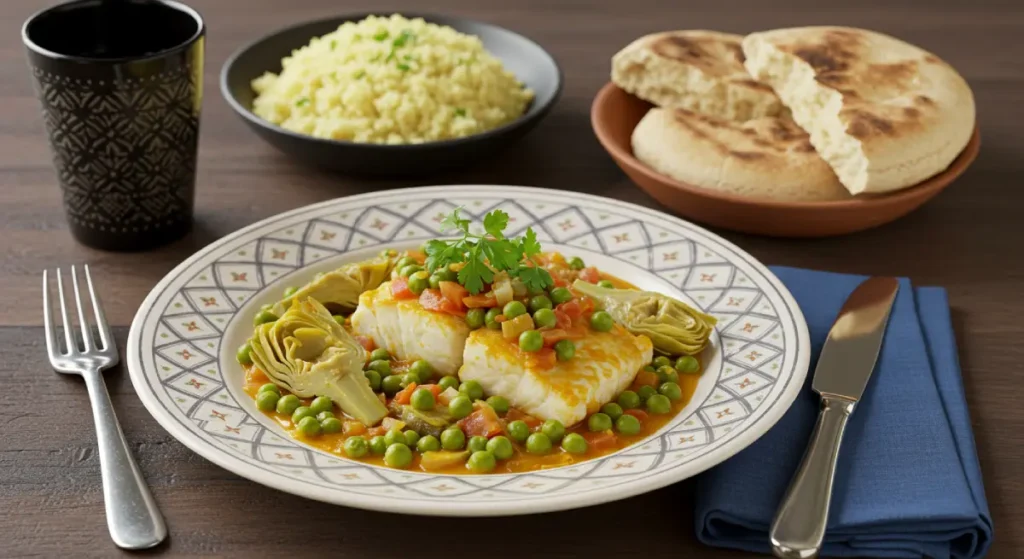
You’ll transform this dish into a true masterpiece by choosing the freshest fish, mastering the art of seasoning, and using the proper cooking methods.
🎨 Remember, the beauty of fish tagine isn’t only in its preparation, it’s in how it’s served and shared with others. Pair it with couscous, warm bread, or fresh salads, and you’ll have a meal to impress everyone around your table.
Whether you’re preparing it for a special occasion or a cozy family dinner, fish tagine is always a crowd-pleaser. With a bit of attention to detail and love, you’ll create a dish that’s as rich in flavor as it is in tradition.
So, gather your ingredients, follow the steps, and enjoy the satisfaction of making this timeless Moroccan delight.
Happy cooking and enjoy the delicious journey! 🧑🍳💚
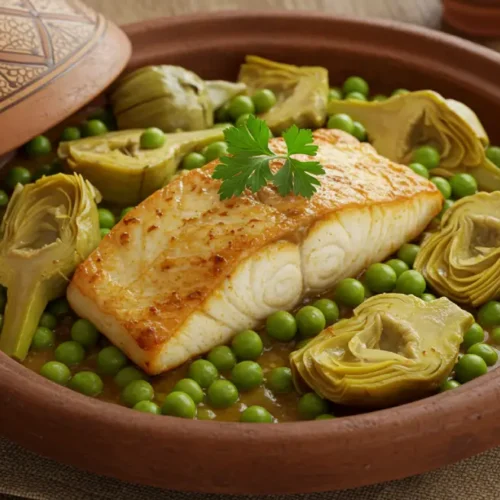
Why Fish Tagine with Artichokes and Peas Should Be Your Next Epic Culinary Adventure
Equipment
- 1 Tagine
Ingredients
- 4 white fish fillets (such as cod or haddock)
- 1 cup fresh or frozen peas
- 2 medium artichokes (trimmed and quartered)
- 2 medium onions, finely sliced
- 3 cloves garlic, minced
- 1 cup chopped tomatoes (fresh or canned)
- 1/2 cup green olives (optional)
- 2 tbsp olive oil
- 1 tsp ground turmeric
- 1 tsp ground cumin
- 1 tsp paprika
- 1/4 tsp ground cinnamon
- 1/4 tsp cayenne pepper (optional, for heat)
- Juice of 1 lemon
- 1/4 cup chopped fresh parsley
- 1/4 cup chopped fresh cilantro
- Salt and pepper to taste
Instructions
- Prepare the Base: Heat olive oil in a large tagine or deep skillet over medium heat. Sauté the onions until soft and golden, about 5 minutes. Add the garlic and cook for another minute.
- Add Spices: Stir in the turmeric, cumin, paprika, cinnamon, and cayenne (if using). Cook for 1 minute to release the flavors.
- Build the Sauce: Add the chopped tomatoes, lemon juice, and a pinch of salt. Simmer for 5 minutes until slightly thickened.
- Layer the Ingredients: Arrange the artichokes, peas, and fish fillets in the tagine or skillet. Scatter olives over the top if desired.
- Simmer and Cook:Cover the tagine or skillet with a lid and reduce heat to low. Cook for 25–30 minutes, until the fish is cooked through and the vegetables are tender.
- Garnish and Serve:Sprinkle with parsley and cilantro before serving. Pair with crusty bread or steamed couscous for a complete meal.
Notes
- You can substitute artichokes with zucchini or bell peppers for a different twist.
- Adjust the spice level by adding more cayenne or omitting it altogether.
- For a richer flavor, marinate the fish in lemon juice and spices for 30 minutes before cooking.
🍽️Nutritional Information for Fish Tagine
| Nutrient | Amount per Serving |
|---|---|
| Calories | 350 kcal |
| Protein | 25 g |
| Carbohydrates | 20 g |
| Fiber | 5 g |
| Sugars | 7 g |
| Fat | 18 g |
| Saturated Fat | 3 g |
| Unsaturated Fat | 12 g |
| Cholesterol | 60 mg |
| Sodium | 500 mg |
| Potassium | 700 mg |
| Vitamin A | 15% of daily value |
| Vitamin C | 30% of daily value |
| Calcium | 6% of daily value |
| Iron | 10% of daily value |
This table presents approximate nutritional information for a typical serving of fish tagine. Values may vary depending on the specific ingredients and portion sizes.
Don’t forget to share your fish tagine creations with us on social media or comment below—we can’t wait to hear how it turned out!📸👇
We’d love to see how your Moroccan masterpiece turns out! Share your photos, tips, and experiences with us. 📸✨
so we can feature your beautiful creations.
Let’s create a community of food lovers, exploring the rich and vibrant tastes of Morocco together! 🌍💚 Follow us for more recipes, tips, and inspiration.
We can’t wait to connect with you! 🙌
📩 Join Our Moroccan Foodie Community
Get the best Moroccan tagine recipes and seasonal culinary tips straight to your inbox.
Discover More Delicious Recipes – Explore Our Home Page! 🍽️✨
Explore more delicious recipes by visiting our Home Page! Whether you’re craving traditional Moroccan dishes or looking to try something new, you’ll find a variety of recipes organized by categories to suit every taste.
🍽️ From savory tagines to fresh salads and comforting stews, our home page is your gateway to culinary inspiration. Dive in, discover your next favorite dish, and start cooking today!
Clarifying Essential Terms and Ingredients
To help you better understand the ingredients and elements mentioned in this article, here are brief explanations of key terms commonly used in Moroccan cuisine:
Khobz
This traditional Moroccan bread is a round, flat loaf with a dense yet soft texture. Used to scoop up tagines, stews, and dips, khobz is a staple in every Moroccan household. Made with simple ingredients like flour, water, salt, and yeast, it embodies the communal and cultural traditions of Morocco.
Ras el Hanout
A hallmark of Moroccan spice blends, “Ras el Hanout” translates to “head of the shop,” representing the finest spices a merchant can offer. This versatile blend typically includes a mix of warming spices such as cinnamon, cumin, turmeric, and ginger, and is used to flavor iconic dishes like tagines and couscous.
Saffron
Revered as “the golden spice,” saffron is obtained from the fine, hand-harvested threads of the crocus flower, making it a rare and precious addition to any dish. It imparts a rich yellow color and a subtle, earthy aroma to Moroccan dishes, from tagines to desserts. Its labor-intensive harvesting process makes it one of the most valuable spices in the world.
💬We’d Love to Hear from You!
Have any thoughts or questions about this fish tagine recipe? Drop a comment below! Your feedback, tips, and experiences are always welcome.
💬✨ Whether it’s your first time making this dish or you’re a seasoned pro, we’d love to hear how it turned out for you. Let’s share our culinary journey together and inspire each other!
